Douglas DC-3 Video - Picture
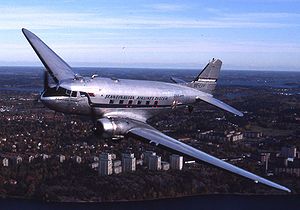
|
|
Douglas DC-3
DC-3

Picture - A DC-3 operated by Flygande Veteraner in Sweden
Role: Airliner and transport aircraft
Manufacturer: Douglas Aircraft Company
First flight: December 17, 1935
Status: More than 400 (c1998)
in limited use
Number built: 16,079: 10,655 (DC-3) + 4,937 (Li-2) + 487 (L2D)
Developed from: Douglas DC-2
Variants: C-47 Skytrain
Lisunov Li-2
Basler BT-67
Conroy Turbo Three
Conroy Tri-Turbo-Three
The Douglas DC-3 is an American fixed-wing propeller-driven aircraft whose speed and range revolutionized air transport in the 1930s and 1940s. Its lasting impact on the airline industry and World War II makes it one of the most significant transport aircraft ever made. Many DC-3s are still used in all parts of the world.
Design and development
The DC-3 originated out of an inquiry from Transcontinental and Western Airlines to Donald Douglas. TWA's rival in transcontinental air service, United Airlines, was inaugurating service with the Boeing 247. Douglas sought to design and build a passenger aircraft that could beat the 247, and take off from any airport TWA served with only one engine running. Douglas' first effort, the 1933 DC-1, was promising, and led to the DC-2 in 1934. While the DC-2 was a success, there was still room for improvement.
The DC-3 was engineered by a team led by chief engineer Arthur E. Raymond and first flew on December 17, 1935 (the 32nd anniversary of the Wright Brothers' flight at Kitty Hawk). The aircraft was the result of a marathon phone call from American Airlines CEO Cyrus Smith to Donald Douglas requesting the design of an improved successor to the DC-2. The amenities of the DC-3 (including sleeping berths on early "DST"-Douglas Sleeper Transport-models and an in-flight kitchen) popularized air travel in the United States. All DC-3s delivered to American Airlines had the main passenger door on the right side of the aircraft, unlike the standard of the aircraft industry before and since., .
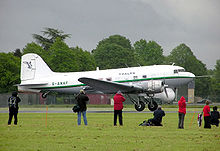
Picture - A Douglas DC-3 (a former military C-47B) of Air Atlantique taking off at Hullavington airfield, England.
With only three refuelling stops, eastbound transcontinental flights across the U.S. taking approximately 15 hours became possible. Westbound trips took 17 hours 30 minutes because of typical prevailing headwinds - still a significant improvement over the competing Boeing 247. During an earlier era, such a trip would entail short hops in slower and shorter range aircraft during the day, coupled with train travel overnight. A variety of engines were fitted to the DC-3 throughout the course of its development. The original civilian aircraft used Wright R-1820 Cyclone 9s, but later aircraft (and the majority of military aircraft) used the Pratt & Whitney R-1830 Twin Wasp radial which offered better high-altitude and single engine performance. A few Pratt & Whitney R-2000 radials saw use.
Production
Total production of the DC-3 was 16,079. More than 400 remained in commercial service in 1998. Production was as follows:
10,655 DC-3s were built at Santa Monica, California, Long Beach, California, and Oklahoma City in both civil DC-3 (607) and military C-47 (10,048) versions. 4,937 were built under license in Russia as the Lisunov Li-2 (NATO reporting name: "Cab"). 487 Mitsubishi Kinsei-engined aircraft were built by Showa and Nakajima in Japan, as the L2D2-L2D5 Type 0 transport.
Production ceased in 1945, although Douglas refurbished some C-47s as DC-3Cs and delivered the last in March 1947. In 1949 a larger more powerful Super DC-3 was launched to positive reviews, but the market was flooded with second-hand C-47s and only three were ever sold. The prototype served the US Navy with the designation YC-129 (alongside 100 C-47s that had been upgraded to Super DC-3 specification).
Turboprop conversions
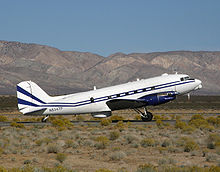
Picture - Highly modified DC-3, a BT-67 powered by two Pratt & Whitney Canada PT6-65AR engines, formerly operated by the National Test Pilot School
From the early 1950s, some DC-3s were modified to use Rolls-Royce Dart engines, as in the Conroy Turbo Three. Other conversions featured Armstrong Siddeley Mamba and Pratt & Whitney PT6A turbines.
The Basler BT-67 is a conversion of the DC-3. Basler refurbishes DC-3s at Oshkosh, Wisconsin, fitting them with Pratt & Whitney Canada PT6A-67R turboprop engines, lengthening the fuselage by 40 in (100 cm) with a fuselage plug ahead of the wing and strengthening the airframe in selected areas. The airframe is rated as having "zero accumulated fatigue damage." This and extensive modifications to various systems and avionics result in a practically brand-new aircraft. The BT-67s have been supplied to civil and military customers in several countries.
Braddick Specialised Air Services International PTY Ltd (BSAS International) in South Africa is another company to perform a turbo-prop conversion to DC-3s designated by the Pratt & Whitney engine model PT6. Over 50 DC3/C47 65ARTP / 67RTP / 67FTPs have been built.
Conroy Aircraft also made a three engine conversion with Pratt & Whitney Canada PT6 called the Conroy Tri-Turbo-Three.
Operational history
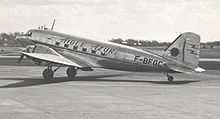
Picture - Douglas C-47B of Aigle Azur (France) in 1953, fitted with a ventral Turbomeca Palas booster jet for hot and high operations.
The initial design for the DC-3 was a product of conversations between the president of American Airlines, C.R. Smith, and Donald Douglas in 1935. American inaugurated passenger service on June 26, 1936, with simultaneous flights from Newark, N.J. and Chicago, IL. Early U.S. airlines like American, United, TWA and Eastern ordered over 400 DC-3s. These fleets paved the way for the modern American air travel industry, quickly replacing trains as the favored means of long-distance travel across the United States.
KLM Royal Dutch Airlines received their first DC-3 in 1936 and it replaced their earlier aircraft types on the service from Amsterdam via Batavia (now Jakarta) and continuing to Sydney, by far the longest scheduled route in the world at the time.
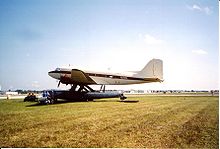
Picture - DC-3 on amphibious EDO floats. Sun-n-Fun 2003, Lakeland, Florida, United States
Piedmont Airlines operated DC-3s from 1948 to 1963. A DC-3 painted in the representative markings of Piedmont, operated by the Carolinas Aviation Museum, continues to fly to air shows today. Both Delta Air Lines and Continental Airlines operate "commemorative" DC-3s wearing period markings.
During World War II, many civilian DC-3s were drafted for the war effort and just over 10,000 US military versions of the DC-3 were built, under the designations C-47, C-53, R4D, and Dakota. Peak production was reached in 1944, with 4,853 being delivered. The armed forces of many countries used the DC-3 and its military variants for the transport of troops, cargo, and wounded.
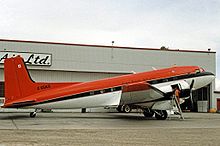
Picture - Ex-US Navy C-117D of Kenn Borek Air at Calgary Airport in 1996
Licensed copies of the DC-3 were built in Japan as Showa L2D (487 aircraft) and in the USSR as the Lisunov Li-2 (4937 aircraft)
Thousands of surplus C-47s, previously operated by several air forces, were converted for civilian use after the war and became the standard equipment of almost all the world's airlines, remaining in front line service for many years. The ready availability of cheap, easily maintained ex-military C-47s, both large and fast by the standards of the day, jump-started the worldwide post-war air transport industry. While aviation in pre-war Continental Europe had used the metric system, the overwhelming dominance of C-47s and other US war-surplus types cemented the use of nautical miles, knots and feet in post-war aviation throughout the world.
Douglas had developed an improved version, the Super DC-3, with more engine power, greater cargo capacity, and a different wing but, with all the bargain-priced surplus aircraft available, this did not sell well in the civil aviation market. Only five were delivered, three of them to Capital Airlines. The U.S. Navy had 100 of their early R4Ds converted to Super DC-3 standard during the early 1950s as the R4D-8, later C-117D. The last U.S. Navy C-117 was retired 12 July 1976. The last U.S. Marine Corps C-117, serial 50835, was retired from active service during June 1982. Several remained in service with small airlines in North and South America in 2006.
A number of aircraft companies attempted to design a "DC-3 replacement" over the next three decades (including the very successful Fokker F27 Friendship), but no single type could match the versatility, rugged reliability, and economy of the DC-3. It remained a significant part of air transport systems well into the 1970s.
The Douglas DC-3 Today
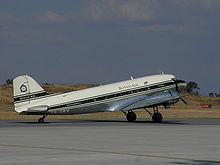
Picture - A C-47A of Rovos Air in service in South Africa, 2006
December 17, 2010, marks the 75th anniversary of the DC-3's first flight, and there are still small operators with DC-3s in revenue service and as cargo aircraft. The common saying among aviation buffs and pilots is that "the only replacement for a DC-3 is another DC-3." The aircraft's legendary ruggedness is enshrined in the lighthearted description of the DC-3 as "a collection of parts flying in loose formation." Its ability to take off and land on grass or dirt runways makes it popular in developing countries, where runways are not always paved.
Some of the uses of the DC-3 have included aerial spraying, freight transport, passenger service, military transport, and sport skydiving shuttling and sightseeing.
Perhaps unique among prewar and wartime aircraft, the DC-3 is in daily use. The very large number of civil and military operators of the DC-3, C-47, and related types means that a listing of all the airlines, air forces and other current operators is impractical.
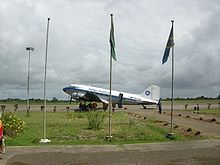
Picture - Indigo Aviation DC-3 before takeoff at Pemba Airport (Tanzania), August 2009
The oldest surviving DC-3 is N133D, the sixth Douglas Sleeper Transport built in 1936. This aircraft was delivered to American Airlines on 12 July 1936 as NC16005. As of November 2010, the aircraft was at Griffin-Spaulding County Airport, Griffin, Georgia, where it was being prepared for a ferry flight to Charlotte County Airport, Punta Gorda, Florida. The aircraft will be restored back to Douglas Sleeper Transport standards, and full airworthiness.
The oldest DC-3 still flying is the original American Airlines Flagship Detroit (c/n 1920, #43 off of the Santa Monica production line), which can be seen at airshows around the United States and is owned and operated by the nonprofit Flagship Detroit Foundation.
Operators
Variants
DC-3
The initial Commercial airliner variant, developed from the DC-1 and DC-2.
DC-3A
Improved DC-3 with two 1,200 hp (895 kW) Pratt & Whitney R-1830-21 radial piston engines.
DC-3B
Improved DC-3 with two Pratt & Whitney R-1820 Cyclone engines.
DST
"Douglas Sleeper Transport", DC-3's fitted out with sleeper accommodation in the cabin.
Super DC-3
Improved DC-3 with a new wing, tail, and powered by two Pratt & Whitney R-2000 engines.
DC-3/2000
DC-3 engine conversion done by Airtech Canada, first offered in 1987. Powered by two PZL ASz-62IT radials.
Basler BT-67
DC-3 conversion with a stretched fuselage, strenghtened structure, modern avionics, and powered by two Pratt & Whitney Canada PT-6A-67R turboprops.
Conroy Turbo Three
One DC-3 converted by Conroy Aircraft with two Rolls-Royce Dart Mk. 510 turboprop engines.
Conroy Super-Turbo-Three
Same as the Turbo Three but converted from a Super DC-3. One converted.
Conroy Tri-Turbo-Three
One DC-3 converted by Conroy Aircraft with three Pratt & Whitney Canada PT-6A turboprops.
LXD1
A single DC-3 supplied for evaluation by the Imperial Japanese Navy Air Service.
Douglas/Showa L2D
487 Licence built DC-3s for the IJNAS.
C-41A
A single DC-3A (40-070) modified as a VIP transport, powered by two 1,200 hp (895 kW) Pratt & Whitney R-1830-21 radial piston engines, used to fly the Secretary of War. (The Douglas C-41 was not a DC-3 derivative but a modification of a Douglas C-33.)
Douglas C-47
Production military DC-3A variant.
C-48
One former United Air Lines DC-3A impressed.
C-48A
Three impressed DC-3As with 18-seat interiors.
C-48B
Sixteen impressed former United Air Lines DST-As with 16-berth interior used as air ambulances.
C-48C
Sixteen impressed DC-3As with 21-seat interiors.
C-49
Various DC-3 and DST models, 138 impressed into service as C-49, C-49A, C-49B, C-49C, C-49D, C-49E, C-49F, C-49G, C-49H, C-49J, and C-49K.
C-50
Various DC-3 models, 14 impressed as C-50, C-50A, C-50B, C-50C and C-50D.
C-51
One aircraft ordered by Canadian Colonial Airlines impressed into service, had starboard-side door.
C-52
DC-3A aircraft with R-1830 engines, five impressed as C-52, C-52A, C-52B, C-52C and C-52D.
C-68
Two DC-3As impressed with 21-seat interiors.
C-84
1 impressed DC-3B aircraft.
R4D-2
Two Eastern Air Lines DC-3s impressed into USN service as VIP transports, later designated R4D-2F and later R4D-2Z.
R4D-4
Ten impressed DC-3s
R4D-4R
Seven impressed DC-3s as staff transports.
R4D-4Q
Radar countermeasures version of R4D-4.
R4D-8
Several R4Ds converted to Super DC-3 standard.
Lisunov Li-2
4,937 DC-3 derivatives licence built in the USSR
Dakota II
RAF designation for impressed DC-3s
Accidents and incidents
Specifications (DC-3)
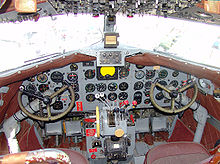
Picture - Cockpit of DC-3 operated by FAA to verify operation of navaids (VORs and NDBs) along federal airways
General characteristics
Crew: 2
Capacity: 21-32 passengers
Length: 64 ft 5 in (19.7 m)
Wingspan: 95 ft 0 in (29.0 m)
Height: 16 ft 11 in (5.16 m)
Wing area: 987 ft² (91.7 m²)
Empty weight: 18,300 lb (8,300 kg)
Loaded weight: 25,200 lb (25,346 with deicing boots, 26,900 in some freight versions) (11,400 kg)
Powerplant: 2x— Wright R-1820 Cyclone 9 series (earliest aircraft) or Pratt & Whitney Twin Wasp S1C3G in the C-47 and later civilian aircraft, 1,100 or 1,200 hp max rating, depending upon engine and model (895 kW) each
Propellers: 3-bladed Hamilton Standard 23E50 series hydraulically controlled constant speed, feathering
Performance
Maximum speed: 237 mph (206 kn, 381 km/h (=Never Exceed Speed (VNE), or Redline speed))
Cruise speed: 150 mph (130 kn, 240 km/h)
Range: 1,025 mi (890 nmi, 1,650 km)
Service ceiling: 24,000 ft (7,300 m)
Rate of climb: 1,130 ft/min (5.73 m/s) initial
Wing loading: 25.5 lb/ft² (125 kg/m²)
Power/mass: 0.0952 hp/lb (157 W/kg)
Notable appearances in media
Related development
C-47 Skytrain
AC-47 Spooky
Lisunov Li-2
Basler BT-67
Comparable aircraft
Boeing 247
Junkers Ju 52
Lockheed Model 18 Lodestar
Saab 90 Scandia
Bibliography
Francillon, René. McDonnell Douglas Aircraft Since 1920: Volume I. London: Putnam, 1979. ISBN 0-87021-428-4.
Gradidge, Jennifer M. The Douglas DC-1/DC-2/DC-3: The First Seventy Years Volumes One and Two. Tonbridge, Kent, UK: Air-Britain (Historians) Ltd., 2006. ISBN 0-85130-332-3.
O'Leary, Michael. "When Fords Ruled the Sky (Part Two)." Air Classics, Volume 42, No. 5, May 2006.
Pearcy, Arthur. Douglas Propliners: DC-1-DC-7. Shrewsbury, UK: Airlife Publishing, 1995. ISBN 1-85310-261-X.
Pearcy, Arthur. Douglas DC-3 Survivors, Volume 1. Bourne End, Bucks, UK: Aston Publications, 1987. ISBN 0-946627-13-4.
Yenne, Bill. McDonnell Douglas: A Tale of Two Giants. Greenwich, Connecticut: Bison Books, 1985. ISBN 0-517-44287-6.
Douglas DC-3 Pictures
More aircraft.
Source: WikiPedia